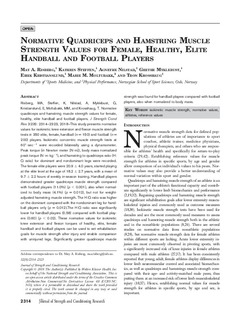| dc.contributor.author | Risberg, May Arna | |
| dc.contributor.author | Steffen, Kathrin | |
| dc.contributor.author | Nilstad, Agnethe | |
| dc.contributor.author | Myklebust, Grethe | |
| dc.contributor.author | Kristianslund, Eirik | |
| dc.contributor.author | Moltubakk, Marie M. | |
| dc.contributor.author | Krosshaug, Tron | |
| dc.date.accessioned | 2019-01-04T12:13:48Z | |
| dc.date.available | 2019-01-04T12:13:48Z | |
| dc.date.created | 2018-11-12T13:35:46Z | |
| dc.date.issued | 2018 | |
| dc.identifier.citation | Journal of Strength and Conditioning Research. 2018, 32, 2314-2323. | nb_NO |
| dc.identifier.issn | 1064-8011 | |
| dc.identifier.uri | http://hdl.handle.net/11250/2579203 | |
| dc.description.abstract | This study presents normative values for isokinetic knee extension and flexion muscle strength tests in 350 elite, female, handball (n = 150) and football (n = 200) players. Isokinetic concentric muscle strength tests at 60°·sec−1 were recorded bilaterally using a dynamometer. Peak torque (in Newton meter [N·m]), body mass normalized peak torque (N·m·kg−1), and hamstring to quadriceps ratio (H:Q ratio) for dominant and nondominant legs were recorded. The female elite players were 20.9 ± 4.0 years, started playing at the elite level at the age of 18.2 ± 2.7 years, with a mean of 9.7 ± 2.2 hours of weekly in-season training. Handball players demonstrated greater quadriceps muscle strength compared with football players (11.0%) (p < 0.001), also when normalized to body mass (4.1%) (p = 0.012), but not for weight-adjusted hamstring muscle strength. The H:Q ratio was higher on the dominant compared with the nondominant leg for handball players only (p = 0.012).The H:Q ratio was significantly lower for handball players (0.58) compared with football players (0.60) (p < 0.02). These normative values for isokinetic knee extension and flexion torques of healthy, elite, female handball and football players can be used to set rehabilitation goals for muscle strength after injury and enable comparison with uninjured legs. Significantly greater quadriceps muscle strength was found for handball players compared with football players, also when normalized to body mass. | nb_NO |
| dc.language.iso | eng | nb_NO |
| dc.subject | adolescent | nb_NO |
| dc.subject | adult | nb_NO |
| dc.subject | body weight | nb_NO |
| dc.subject | Female | nb_NO |
| dc.subject | hamstring muscles / physiology | nb_NO |
| dc.subject | humans | nb_NO |
| dc.subject | knee joint / physiology | nb_NO |
| dc.subject | muscle strength | nb_NO |
| dc.subject | quadriceps muscle / physiology | nb_NO |
| dc.subject | range of motion, articular | nb_NO |
| dc.subject | reference values | nb_NO |
| dc.subject | soccer / physiology | nb_NO |
| dc.subject | torque | nb_NO |
| dc.subject | young adult | nb_NO |
| dc.title | Normative Quadriceps and Hamstring Muscle Strength Values for Female, Healthy, Elite Handball and Football Players | nb_NO |
| dc.type | Journal article | nb_NO |
| dc.type | Peer reviewed | nb_NO |
| dc.description.version | publishedVersion | nb_NO |
| dc.rights.holder | This is an open-access article distributed under the terms of the Creative Commons Attribution-Non Commercial-No Derivatives License 4.0 (CCBY-NC-ND), where it is permissible to download and share the work provided it is properly cited. The work cannot be changed in any way or used commercially without permission from the journal. | nb_NO |
| dc.source.journal | Journal of Strength and Conditioning Research | nb_NO |
| dc.identifier.doi | 10.1519/JSC.0000000000002579 | |
| dc.identifier.cristin | 1629510 | |
| dc.description.localcode | Seksjon for idrettsmedisinske fag / Department of Sport Medicine | nb_NO |
| cristin.unitcode | 150,34,0,0 | |
| cristin.unitcode | 150,31,0,0 | |
| cristin.unitname | Seksjon for idrettsmedisinske fag | |
| cristin.unitname | Seksjon for fysisk prestasjonsevne | |
| cristin.ispublished | true | |
| cristin.fulltext | original | |
| cristin.qualitycode | 1 | |
